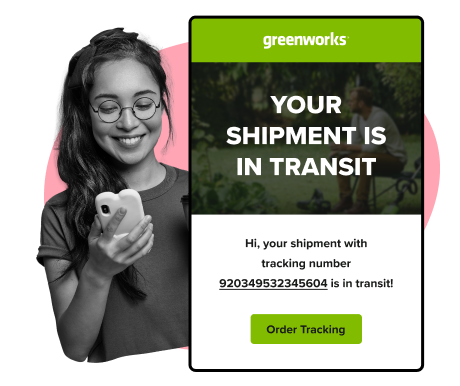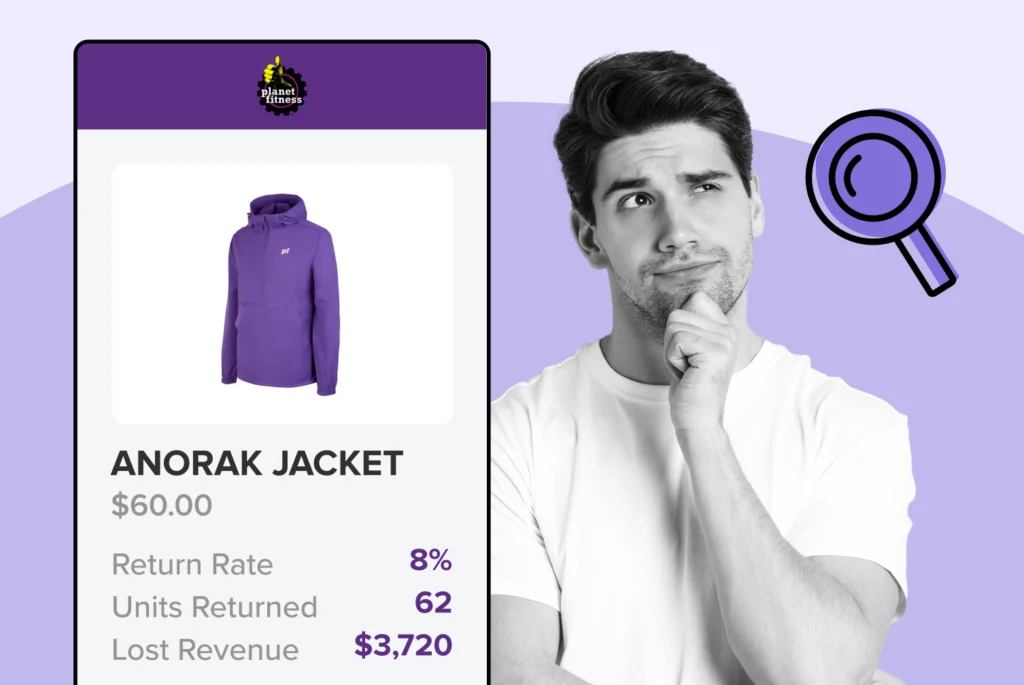
8 Chargeback Mistakes Merchants Must Avoid
Avoid costly chargeback mistakes that hurt your bottom line. Learn key strategies for improved profitability. Boost your business!
Shipping, Tracking & Notifications
Boost customer experience and reduce support tickets
Realtime order and shipment tracking
Proactive order and shipping notifications
AI-Enhanced Discounted Labels
Predictive pre-purchase estimated delivery dates
Self-Serivce branded order tracking
Effortless experience delivered
Identify and Resolve Order Issues
Realtime order and shipment tracking
Make returns profitable and delight customers
Flexibility to define any return destinations & conditions
Simplify returns for your customers and team
Incentivize exchanges over returns
Returns management made easy for your team
Returns management made easy for your team
Easy claims and smart upsells
Understand why your customers are returning
In-Store & Curbside Pickup
Unify the online and the in-store experience
Hassle-free pickup experience for customers
In-Store dashboard to keep operations streamlined
In-Store and Online orders unified
Drive foot-traffic to your stores
Shipping, Tracking & Notifications
Boost customer experience and reduce support tickets
Realtime order and shipment tracking
Proactive order and shipping notifications
AI-Enhanced Discounted Labels
Predictive pre-purchase estimated delivery dates
Self-Serivce branded order tracking
Effortless experience delivered
Identify and Resolve Order Issues
Realtime order and shipment tracking
Make returns profitable and delight customers
Flexibility to define any return destinations & conditions
Simplify returns for your customers and team
Incentivize exchanges over returns
Returns management made easy for your team
Returns management made easy for your team
Understand why your customers are returning
In-Store & Curbside Pickup
Unify the online and the in-store experience
Hassle-free pickup experience for customers
In-Store Dashboard to keep operations streamlined
In-Store and Online orders unified
Drive foot-traffic to your stores
Boost customer experience and reduce support tickets
Realtime order and shipment tracking
Proactive order and shipping notifications
AI-Enhanced Discounted Labels
Predictive pre-purchase estimated delivery dates
Self-Serivce branded order tracking
Effortless experience delivered
Make returns profitable and delight customers
Flexibility to define any return destinations & conditions
Simplify returns for your customers and team
Incentivize exchanges over returns
Returns management made easy for your team
Equip your team for precise return checks.
Easy claims and smart upsells
Understand why your customers are returning
Unify the online and the in-store experience
Hassle-free pickup experience for customers
In-Store Dashboard to keep operations streamlined
In-Store and Online orders unified
Drive foot-traffic to your stores
Find the answer to all your questions
Take a step by step trip through our functionality to see how we can improve your ecommerce processes.
Explore the most comon questions about WeSupply
Calculate the ROI that WeSupply can bring you
Read actionable articles on how to optimize your post-purchase experience and decrease support tickets
Get inspired by stories of how our customers implemented an effortless post-purchase experience
Wondering if WeSupply is a good fit for you? Read through our use cases to see how we can help you increase conversion & improve CX!
A Deep Dive into Top Companies' Order Tracking & Returns Strategy
Find the answer to all your questions
Explore the most comon questions about WeSupply
Calculate the ROI that WeSupply can bring you
Request a no strings attached review of your current shopping experience and missed conversion opportunities
Take a step by step trip through our functionality to see how we can improve your ecommerce processes.
Read actionable articles on how to optimize your post-purchase experience and decrease support tickets
Get inspired by stories of how our customers implemented an effortless post-purchase experience
A Deep Dive into Top Companies' Order Tracking & Returns Strategy
Wondering if WeSupply is a good fit for you? Read through our use cases to see how we can help you increase conversion & improve CX!

In today’s competitive market, effective reverse logistics is more than just a logistical task; it’s a key factor in managing product returns, brand protection, and customer satisfaction. Reverse logistics, the process of managing returns from consumers back to manufacturers, is essential for maintaining brand reputation, fostering customer trust, and ensuring long-term business success. This article explores how reverse logistics can help protect your brand, enhance trust, and improve your overall customer experience.
Buyer’s remorse occurs when a shopper feels regret or doubt about a purchase decision. This typically manifests after the purchase is completed, when the customer reflects on the decision and wonders whether they spent their money wisely. This feeling often leads to the urge to return the product, seek a refund, or avoid purchasing from the same retailer in the future.
Reverse logistics is a crucial component of modern supply chain management, ensuring that returns are handled in a way that aligns with a brand’s image and customer satisfaction goals. With returns accounting for a significant percentage of sales, businesses must develop an efficient reverse logistics process to maintain both operational efficiency and brand integrity.
Traditional logistics focuses on the movement of goods from the supplier to the consumer. This one-way flow is essential for fulfilling customer orders and maintaining supply chain operations. On the other hand, reverse logistics involves the movement of goods in the opposite direction: from the customer back to the business. This process is far more complex because it requires managing returns, assessing product conditions, and optimizing reverse logistics operations to determine the best course of action for each returned item.
Unlike traditional logistics, reverse logistics can impact a brand’s reputation. Mismanaged returns or unclear policies can lead to dissatisfaction, tarnishing a business’s image. Therefore, businesses must carefully manage both logistics processes to ensure consistent and positive customer experiences.
Reverse logistics creates value by directly contributing to customer satisfaction. As eCommerce continues to grow, customers expect a seamless and hassle-free returns process. A smooth return experience ensures that customers feel valued, even when they are dissatisfied with a product. For instance, offering easy returns without excessive paperwork, long wait times, or hidden fees can transform a potentially negative experience into a positive one.
Moreover, brands that excel in reverse logistics often see a boost in customer loyalty, repeat purchases, and positive word-of-mouth. Satisfied customers are more likely to refer friends and share positive reviews on social media, which strengthens the brand’s online presence and reputation.
Reverse logistics create significant value by affecting customer satisfaction and business efficiency. By managing returns efficiently, businesses can reduce waste, recover value, and complete the product lifecycle through strategies like refurbishing, reselling, or recycling.
Moreover, reverse logistics plays a pivotal role in the circular economy, where the flow of goods is not linear but instead continues in a closed-loop system. This results in sustainability benefits, cost savings, and enhanced brand value, as businesses align themselves with environmentally conscious practices.
The reverse logistics process is a critical component of supply chain management that involves the movement of goods from the end customer back to the manufacturer or a designated facility for repair, refurbishment, or disposal. This process is essential for businesses to recover revenue from used or obsolete equipment, reduce waste, and increase customer satisfaction. By effectively managing the reverse flow of products, companies can optimize their supply chains, enhance customer loyalty, and contribute to sustainability efforts.
The reverse logistics process involves several key steps, each crucial for ensuring that returned products are handled efficiently and responsibly:
Collection: The process begins with the collection of returned products from customers. This can be done through various channels, such as in-store returns, mail-in returns, or online returns. Efficient collection methods are vital for minimizing customer inconvenience and ensuring a smooth return experience.
Transportation: Once the products are collected, they are transported to a designated facility for processing. This step requires careful coordination to ensure timely and cost-effective transportation, which is essential for maintaining customer satisfaction and operational efficiency.
Inspection: The returned products are inspected to determine their condition and whether they can be repaired, refurbished, or disposed of. This step is critical for assessing the value that can be recovered from the returned items and for making informed decisions about their next destination.
Repair/Refurbishment: Products that can be repaired or refurbished are sent to a repair facility where they are restored to their original condition. This not only extends the product’s lifecycle but also provides an opportunity to resell the item, thereby recovering value and reducing waste.
Disposal: Products that cannot be repaired or refurbished are disposed of in an environmentally responsible manner. Proper disposal practices are essential for complying with regulations and for maintaining a brand’s commitment to sustainability.
Recycling: Products that can be recycled are sent to a recycling facility where they are broken down into raw materials that can be used to manufacture new products. Recycling helps reduce the environmental impact of waste and supports the circular economy by reintroducing materials into the supply chain.
Evaluating the returned product(s) is a critical step in the reverse logistics process. This involves a thorough inspection to determine the product’s condition and whether it can be repaired, refurbished, or disposed of. The evaluation process typically includes checking the product for damage, testing its functionality, and assessing its overall condition. Accurate evaluation is essential for making informed decisions about the next steps and for maximizing the value recovered from returns.
Once the returned product has been evaluated, it is moved to its processing destination. This can include a repair facility, a refurbishment facility, a recycling facility, or a disposal facility. The product is transported to its destination using a variety of transportation modes, such as truck, air, or sea. Efficient transportation logistics are crucial for minimizing costs and ensuring that the product reaches its destination promptly and in good condition.
WeSupply’s Automated Returns Management solution streamlines the reverse logistics process, helping businesses save time, reduce costs, and enhance customer satisfaction. Key features include:
Streamline Returns: Automatically enforce return policies, calculate restocking fees, and detect return fraud, ensuring a seamless workflow and fraud prevention.
Enhance Quality Control: Facilitate thorough inspection with tools for customer-provided feedback, images, and warehouse notes, ensuring accurate inventory decisions.
Intelligent Dispositions: Dynamically route returns to the appropriate destination, such as warehouses, recycling centers, or donation facilities, reducing costs and environmental impact.
With WeSupply, businesses transform returns into an efficient and sustainable process, turning challenges into opportunities for growth and enhanced customer trust.
Reverse logistics encompasses several types of processes, each critical for optimizing operations and promoting sustainability. These include:
Returns Management: Ensuring smooth and efficient customer returns to maintain satisfaction and loyalty.
Remanufacturing and Refurbishment: Restoring returned products for resale, recovering value, and reducing waste.
Recycling: Breaking down products into reusable raw materials, fostering sustainability and supporting the circular economy.
Disposal: Environmentally responsible disposal of non-repairable items to comply with regulations and minimize environmental impact.
WeSupply simplifies and enhances these reverse logistics processes with innovative solutions:
Intelligent Dispositions: Automatically route returned items to appropriate destinations like warehouses, recycling centers, or donation facilities, reducing transportation costs and emissions.
Green Returns: Allow customers to keep low-cost items, saving costs on labels and boosting satisfaction with quick refunds or exchanges, while minimizing waste.
By integrating WeSupply’s advanced tools, businesses can create a robust reverse logistics strategy that enhances customer trust, recovers lost profits, and supports sustainability.
The way reverse logistics work can significantly influence a business’s relationship with customers. A seamless returns process can transform a negative experience into a positive one, leading to increased customer loyalty. When a customer knows they can return an item easily and without hassle, it boosts their confidence in the brand and enhances their overall experience. This, in turn, encourages repeat purchases and fosters a sense of loyalty.
WeSupply Advantage:
Keep your customers engaged during the return experience
Book a quick call with our experts to see how WeSupply can help you engage your customers with relevant updates through the right channel, at the right time.
A well-managed reverse supply chain can significantly improve a brand’s public image. Customers who have a positive returns experience are more likely to share their satisfaction with others, which improves a brand’s reputation and visibility. By turning potentially negative returns into positive customer experiences, businesses can differentiate themselves from competitors and enhance brand loyalty.
WeSupply Advantage:
Branded Returns Portal: Maintain your brand identity throughout the returns process, reinforcing recognition and trust.
Customer Feedback Tools: Leverage NPS and CSAT data to refine returns processes and showcase success stories that highlight customer satisfaction.
Clear and transparent return policies build customer confidence and foster long-term loyalty. When customers understand what to expect, they feel empowered and secure in their purchase decisions.
WeSupply Advantage:
Policy Enforcer: Automate compliance with transparent, customer-friendly policies to build a reliable and trustworthy process.
Fraud Prevention Tools: Detect and block return fraud, ensuring fairness and maintaining customer trust.
Returns management is crucial for preserving a brand’s reputation, especially for high-end or exclusive products. Proper refurbishment, recycling, or disposal ensures that brand value remains intact and supports sustainability goals.
WeSupply Advantage:
Quality Control Features: Use inspection notes and customer-provided images to maintain high standards for refurbished goods and protect your brand value in resale markets.
By integrating WeSupply’s comprehensive solutions into your reverse logistics framework, you can enhance customer loyalty, protect your brand reputation, and turn returns into an opportunity for sustainable growth and differentiation.
One of the biggest challenges in reverse logistics is ensuring that the returns process is as simple as possible for customers. Complicated return procedures, unclear instructions, or excessive requirements can frustrate customers and lead to negative feedback. A difficult return experience may even prevent customers from making future purchases. This can damage a brand’s reputation and customer trust, making it essential to streamline returns to ensure satisfaction. Implementing effective packaging management strategies, such as reusing packaging materials and having customers return faulty products in their original packaging, can enhance sustainability and simplify the returns process.
WeSupply Solutions:
Autogenerated QR Code Return Labels
We’re making it easier for customers to return online purchases without the hassle of printing by simply scanning a QR code from the email.
Returns Tracking
Customers expect to track the progress of their returned product and check the status whenever they want, in just a few clicks.
Confusion-Free Return Windows
Since when are we counting the simple 30-day return policy from? It can be really confusing for your customers and your team. WeSupply helps avoid unnecessary confusion and unwanted returns!
Simplify Returns for Your Customers and Support Team
Book a quick call with our experts to see how WeSupply can help you: simplify the Return experience with just a few clicks, reduce customer service calls and manual processing, notify your customer about their refund, automate returns and reduce user error
Operational inefficiencies in handling returns can result in increased costs and loss of brand reputation. For example, improperly processed or inspected returns can lead to defective products being resold, which creates dissatisfaction and tarnishes the brand image. Inefficient warehouse operations, poor product tagging, or mismanagement of returns inventory can lead to wasted resources, increased operational costs, and customer complaints. Implementing a Warehouse Management System (WMS) can significantly improve efficiency and management of warehouse space by automating processes such as receiving, sorting, and storing returned products.
WeSupply Solutions:
Integration Tools: Seamlessly integrates with existing WMS systems to optimize receiving, sorting, and storing of returned products, improving efficiency.
Automate Multiple Shipments per Return: Makes it simple to handle returns involving multiple packages. Whether it’s more cost-effective to return smaller boxes or easier to use original packaging, WeSupply automates the creation of multiple return labels as needed.
Quality Control Features: Offers detailed inspection tools, including image collection and warehouse feedback, to ensure only high-quality items are resold, protecting brand integrity.
Comprehensive Analytics: Delivers actionable insights into return patterns and operational bottlenecks, enabling continuous improvement of reverse logistics strategies.
By leveraging WeSupply Labs’ innovative solutions, businesses can overcome the challenges of reverse logistics, providing a seamless customer experience, optimizing operations, and safeguarding brand reputation while aligning with sustainability goals.
One of the most effective ways to optimize reverse logistics is by ensuring that your returns policy is clear, concise, and customer-friendly. A transparent returns policy helps foster trust and confidence in your brand. Clearly outlining the conditions for returns, exchanges, and refunds ensures that customers know exactly what to expect, reducing confusion and potential frustration.
A well-defined return policy builds customer trust by providing clarity on how returns are handled, including timelines, fees, and conditions. Transparency about the returns process reassures customers that they won’t encounter unexpected obstacles if they need to return a product, which can strengthen their loyalty and satisfaction.
Another strategy for optimizing reverse logistics is analyzing why customers return products. By collecting data on return reasons, businesses can identify patterns and address any underlying issues with the product. For example, if a particular product is frequently returned due to sizing issues, it may indicate the need for improved sizing guides or better product descriptions.
Gathering insights from return reasons can help businesses refine their products and processes. Analyzing return trends enables companies to improve product design, prevent future returns, and optimize inventory management. This data-driven approach helps prevent losses and ensures that customers receive higher-quality products that meet their expectations.
Return data can also inform product development. By understanding the reasons behind customer returns, brands can make design improvements or adjust marketing strategies to better meet customer expectations. Additionally, addressing recurring return issues can enhance the overall customer experience and reduce dissatisfaction.
To protect brand value, businesses must streamline their reverse logistics process. By implementing best practices for tracking, tagging, and storing returned products, brands can reduce operational inefficiencies and minimize costs. Automating aspects of the returns process can also speed up processing times and ensure a smoother experience for customers.
A well-managed reverse logistics process helps brands minimize costs by reducing waste and avoiding the mishandling of returned items. By improving operational efficiency, businesses can protect their brand from negative perceptions caused by poor returns handling and increase profitability.
Implementing best practices for managing returned goods is essential for ensuring that items are properly processed and tracked throughout the reverse logistics process. Proper tagging and storage ensure that products are not lost, misplaced, or forgotten. Effective tracking and inventory management also contribute to more efficient operations and better brand protection.
Implementing best practices for managing returned goods is essential for ensuring that items are properly processed and tracked throughout the reverse logistics process. Proper tagging and storage ensure that products are not lost, misplaced, or forgotten. Effective tracking and inventory management also contribute to more efficient operations and better brand protection.
WeSupply offers innovative solutions to help businesses enhance their reverse logistics strategies while protecting brand reputation and increasing customer satisfaction. Key features include:
Flexible Returns Rules: Tailor return policies to accommodate various scenarios, creating a hassle-free customer experience while maintaining operational efficiency.
Comprehensive Returns Analytics: Gain actionable insights by identifying patterns and trends in return reasons to refine products and processes.
Customer Feedback Collection: Collect detailed feedback to address recurring issues, improve products, and boost customer satisfaction.
Return Trends Dashboard: Monitor product-specific return data, including sizing or quality concerns, to inform product design and marketing strategies.
Automated Returns Management: Streamline returns processes to improve efficiency, reduce errors, and provide a seamless experience for customers.
Reverse logistics is an essential aspect of modern business operations. It plays a critical role in protecting your brand, enhancing customer trust, and ensuring operational efficiency. By refining your reverse logistics process—through transparent returns policies, data-driven insights, and streamlined operations—you can turn returns into opportunities for improving customer experience and increasing profitability. In today’s competitive landscape, an optimized reverse logistics strategy is not just a logistical necessity; it’s a key driver of long-term business success and brand protection.
WeSupply empowers businesses to optimize reverse logistics, protecting brand reputation while delivering a seamless customer experience. With flexible returns rules, WeSupply enables hassle-free, tailored policies, complemented by a branded returns portal for a customer-centric experience that builds trust. Comprehensive returns analytics and a return trends dashboard provide actionable insights to improve products and processes, while customer feedback collection helps enhance satisfaction through targeted improvements. Automated returns management streamlines operations, reducing errors and ensuring efficiency. Intelligent dispositions and warehouse integration tools optimize routing and inventory management, minimizing costs and waste. Proactive notifications and real-time returns tracking enhance transparency, fostering customer loyalty. Transform your reverse logistics into a competitive edge—get started with WeSupply today!
WeSupply simplifies returns to create a positive customer experience:
Self-Service Returns Portal: 24/7 return initiation without support.
Proactive Notifications: Real-time updates on return status.
Confusion-Free Return Windows: Clear policies to avoid misunderstandings.
WeSupply streamlines operations to lower costs and protect your brand:
Intelligent Dispositions: Route items to the right destinations efficiently.
Integration Tools: Optimize returned item management.
Automate Multiple Shipments per Return: Flexible, cost-effective return labels.
WeSupply turns return data into actionable insights:
Comprehensive Analytics: Identify and address return trends.
Customer Feedback Collection: Improve products based on feedback.
Yes, WeSupply does have an official Shopify App. You can download and begin to integrate it with your Shopify store.
Yes, WeSupply has an official extension for Magento. The WeSupply x Magento integration allows for automating order tracking experiences, reducing customer inquiries, automating shipping email and SMS notifications, and providing a fully branded order tracking experience
Yes, WeSupply has an official BigCommerce App. You can integrate WeSupply with your BigCommerce store to improve your post-purchase customer experience.

Learn How To Create Successful Post Purchase Email Campaigns
Build an effective post-purchase email flow that helps you increase customer satisfaction and drive revenue growth!
Consumers seek the best deals on:

Avoid costly chargeback mistakes that hurt your bottom line. Learn key strategies for improved profitability. Boost your business!

Discover how adopting green practices in reverse logistics can enhance efficiency and drive success. Transform your approach today!

Discover how to reduce product returns using data-driven strategies. Enhance your eCommerce success with our step-by-step guide!

Discover effective strategies to reduce buyer’s remorse in ecommerce and enhance customer satisfaction. Discover practical solutions today!

Discover how returns play a vital role in reducing e-waste and promoting sustainability. Learn practical steps to make a positive impact!

Discover 4 effective strategies for information sharing that can significantly reduce product returns. Enhance your customer experience!

Discover why a poor returns policy can hurt your business and learn how to create a customer-friendly approach!

Discover 5 effective strategies to minimize returns and reduce losses in your business. Improve your processes for greater success!

Discover effective returns strategies to minimize losses in ecommerce. Enhance your business’s resilience and improve customer satisfaction!